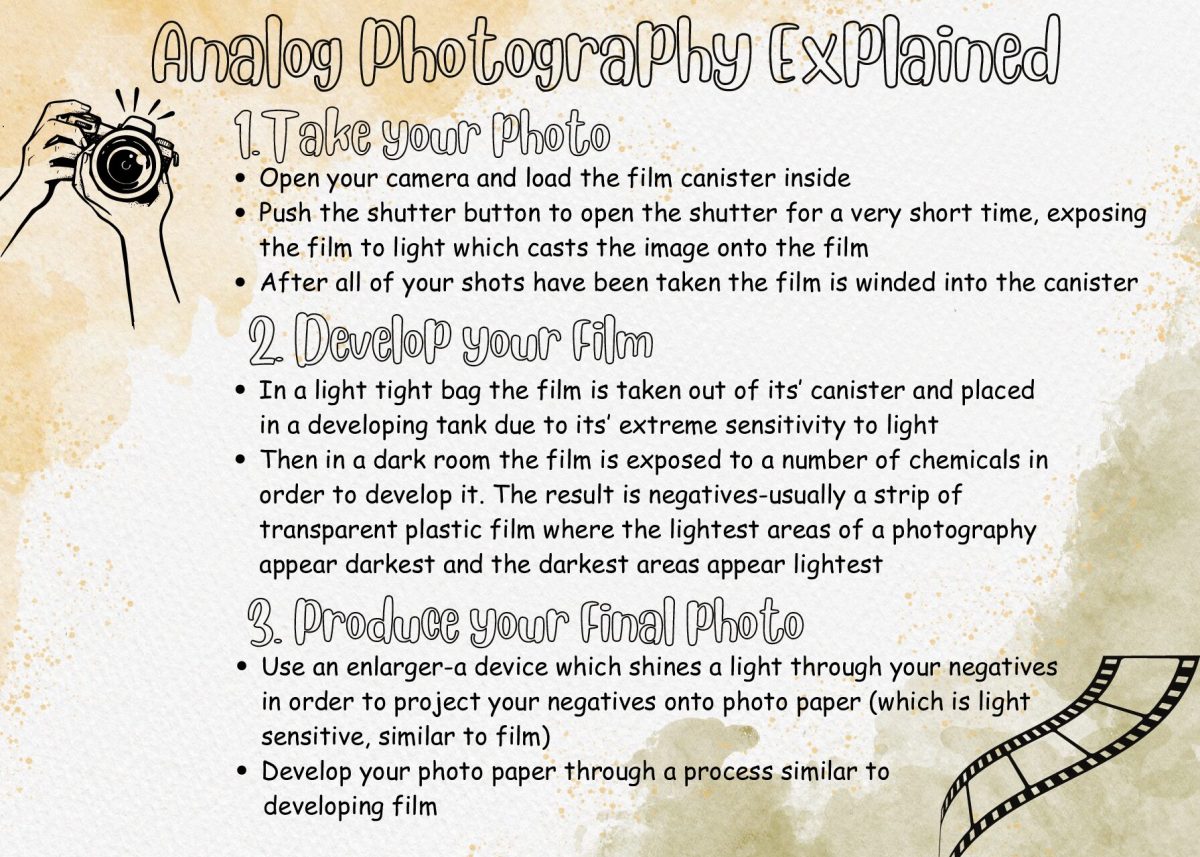From the first camera in 1816 which was the size of a room, to cameras that fit in our hands today, photography has a long and rich history. Although today many people prefer to use their phones to take pictures, the photography class aims to teach students about photography before the smartphone by using film cameras.
“I love that it’s hands-on. And it’s not digital. And what you take a photo of is exactly that second in time,” Elizabeth Knodle, photography teacher, said. “And I think especially now with iPhones that’s kind of precious because you can’t take 300 pictures and decide which one’s good. You have to kind of slow down and be more decisive.”
The photography class provides students with the unique opportunity to learn about film photography, which is becoming more and more rare in the age of digital photography.
“Our class is completely what we call analog,” Knodle said. “It is all film. It’s all black and white. We process and print our own photos.”
While learning not only how to take photos but also how to develop film allows students to be more independent in their creative process, developing film can be hard at first.
“It’s [the film developing process] run almost like a science lab because it takes 25 to 30 minutes to develop a roll of film. They typically work with a partner and follow a very step-by-step decisive set of directions to process their film,” Knodle said. “We demonstrate and practice how to get the film out of the canister onto a reel and into a tank in this bag [film changing bag] numerous times before we do it because the film is so sensitive to light that you can’t even do it in the dark room with the safe lights. We use a changing bag so it’s completely pitch dark.”
In addition to learning how to use an analog camera and develop film chemically to produce negatives, the photography course teaches students other important photography skills.
“[Using their negatives] they learn to use the enlargers in the darkroom to print their photographs on paper,” Knodle said. “And then they also learn about different photographers and the history of photography. We also do other collage projects that help with the concepts of photography, such as composition, creating meaning [in their photographs] and how to hone in and look at things in terms of value and not color since we’re doing all black and white [photography].”
Teaching the process of developing film and using the enlarger can be challenging. However, Knodle isn’t afraid of the challenge and enjoys teaching the process.
“I really like teaching how to use the enlarger and the chemical process in the darkroom because in one bell the students can see all of the steps of the darkroom and then transfer that knowledge to processing and printing their own photographs,” Knodle said.
While students in photography learn many different amazing skills there is one element that seems to be their favorite part.
“[I think] It’s definitely the ability to have creative freedom,” Knodle said. “We do units and I give them prompts and techniques, but I let them really take pictures of their world and experiences the way they are authentically experiencing them.”
In the age of digital photography, having physical photographs printed out is becoming more and more of a rarity.
“I always tell students that I have probably 30,000 pictures on my phone, and yet I have very few real photos printed of even my own kids,” Knodle said. “It’s nice to have the tactile real memory printed out.”
Another reason that students might take photography is to try something new.
“I think they’re students that sign up for photography because it’s not drawing or painting which they think they might not be good at and they somehow realize [through photography] that they actually are artistic or creative, which is always rewarding to know,” Knodle said.
While the class is only a semester long, the students’ photography journey doesn’t have to end there.
“If they continue with photography, that’s beautiful,” Knodle said.” And if they don’t [I hope they] have an appreciation for the old ways of taking photos, even if they just continue to take pictures with their phone to document their world.”
For students who wish to continue with photography classes, there may be a new opportunity for them in the future.
“I’m hoping that in the future we can initiate a photo two course, but I’ve also had students that have taken Photo I again, to have the opportunity to continue to use the dark room and the space,” Knodle said. “There are also dark rooms you can join in Cincinnati, outside of school.”
While some students may continue with photography and others may not, Knodle has one goal for what all of her students will know at the end of the class.
“I hope that they take away that they are creative and they have something to say or show about their experience in the world, and they [now] have a keener sense of observation of life and take time to look around,” Knodle said.



